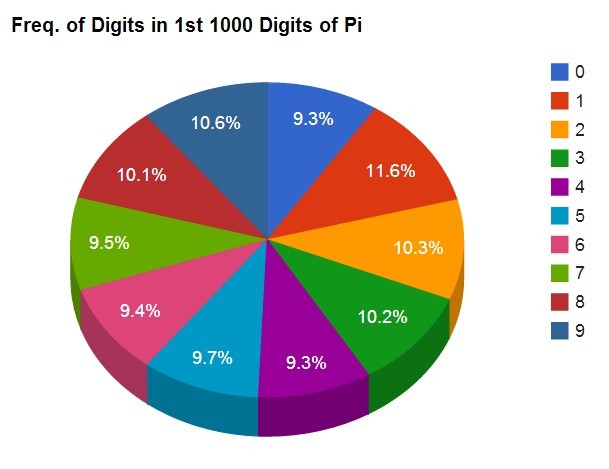views

The image you provided is a compelling pie chart titled "Freq. of Digits in 1st 1000 Digits of Pi." This visualization offers a fascinating glimpse into the statistical behavior of one of the most famous and mysterious mathematical constants: Pi (π).
The chart breaks down the occurrences of each digit from 0 to 9 within the first 1000 decimal places of Pi. Each slice of the pie represents a specific digit, and its size corresponds to the percentage of times that digit appears in that initial segment of Pi's infinite sequence. For instance, you can see that the digit '3' appears with a frequency of 11.6%, while '7' appears at 9.4%.
The Phenomenon: Digit Distribution and Normal Numbers
The core concept illustrated here relates to the idea of a normal number. A normal number is a real number whose digits in any given base are uniformly distributed. This means that, in the long run, each digit (0-9 in base 10) should appear approximately the same number of times – ideally, 10% for each digit. Similarly, any sequence of two digits (like "00", "01", etc.) should appear 1% of the time, and so on.
While it is widely conjectured that Pi is a normal number, this has not yet been mathematically proven. The pie chart, by showing the frequencies in the first 1000 digits, provides empirical evidence that supports this conjecture. If Pi were perfectly normal, each digit would appear exactly 100 times in the first 1000 digits, resulting in a perfectly uniform 10% for each slice.
Insights from the Chart:
Observing the chart, we can see that while the frequencies are not exactly 10% for each digit, they are remarkably close. For example:
-
Digit '3' is slightly overrepresented at 11.6%.
-
Digits like '7' and '9' are slightly underrepresented at 9.4% and 9.3% respectively.
-
Most other digits hover very close to the ideal 10% mark.
This near-uniform distribution in the initial 1000 digits is a characteristic that mathematicians find incredibly intriguing and is part of the ongoing research into the fundamental properties of Pi. It suggests a lack of discernible pattern or bias in its digits, reinforcing its seemingly random yet balanced nature.
The visualization serves as a simple yet powerful way to understand a complex mathematical property, demonstrating how even in a seemingly chaotic sequence of numbers, a fascinating order can emerge. It's a testament to the beauty and mystery embedded within mathematical constants like Pi.




















Comments
0 comment